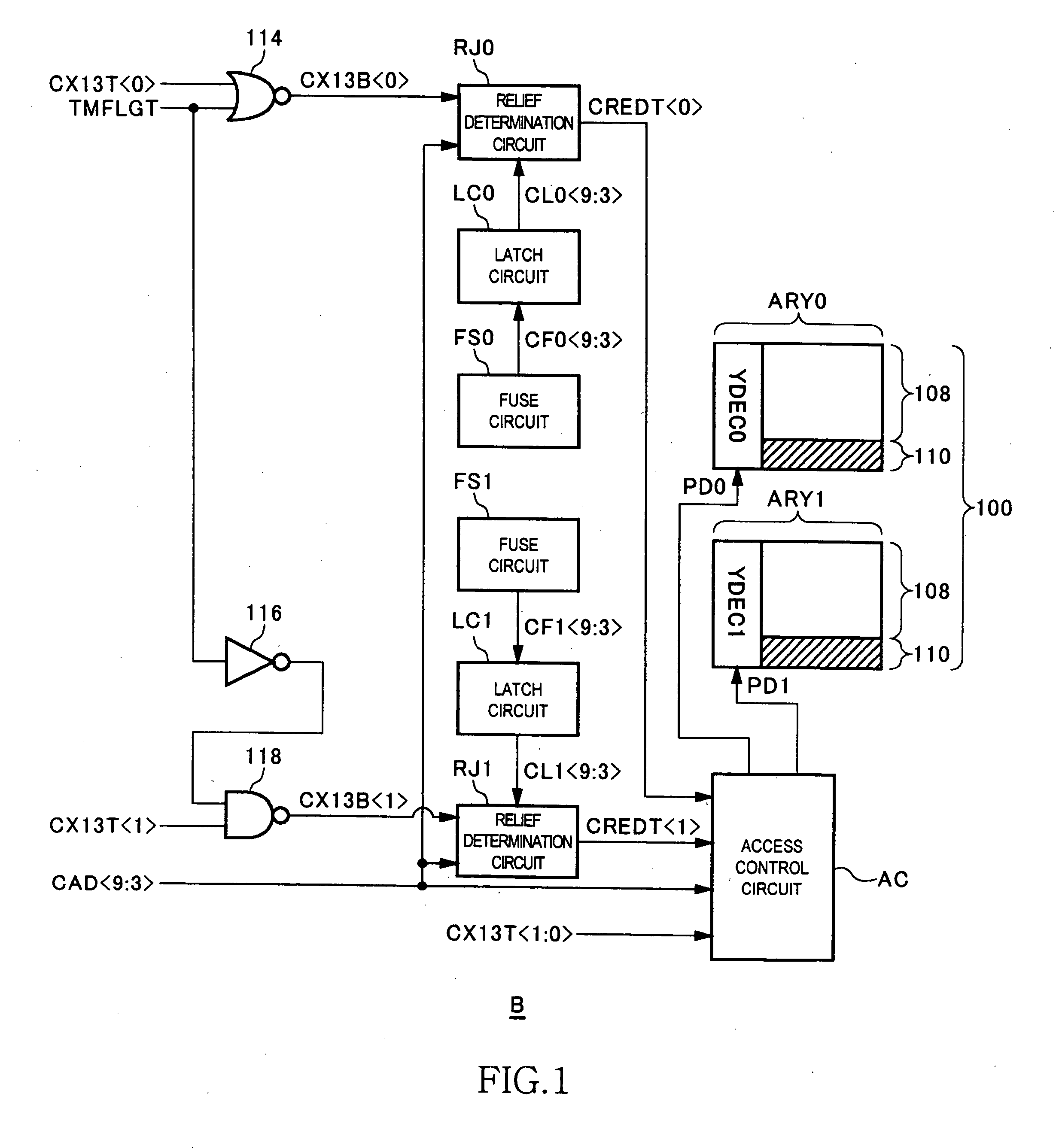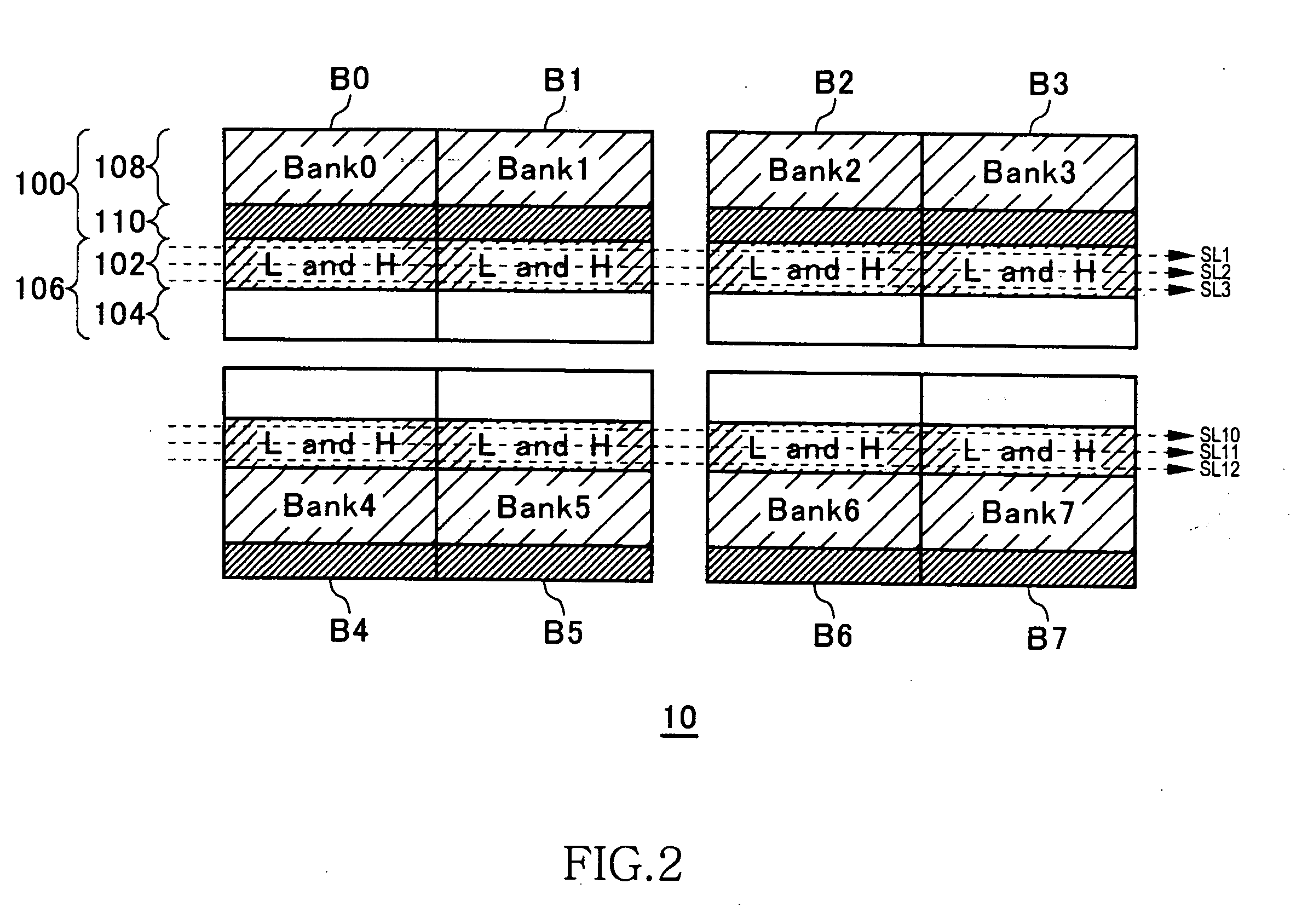Semiconductor memory device having regular area and spare area
- Summary
- Abstract
- Description
- Claims
- Application Information
AI Technical Summary
Benefits of technology
Problems solved by technology
Method used
Image
Examples
first embodiment
[0024]FIG. 1 is a peripheral circuit diagram of a bank B of a semiconductor memory device 10 according to a first embodiment of the present invention. A description will be given of a circuit configuration of the bank B first and then operation thereof. The circuit illustrated in FIG. 1 is housed in one bank B. A memory area 100 of the bank B is roughly divided into a lower address side memory array ARY0 (first memory area) and an upper address side memory array ARY1 (second memory area). In the present embodiment, it is assumed that the bank have an address width of 13 bits and that an address whose most significant bit (X=13) is 0 correspond to the memory array ARY0 and address whose most significant bit (X=13) is 1 correspond to the memory array ARY1.
[0025]The memory arrays ARY0 and ARY1 each include a regular area 108 and a spare area 110 and have, respectively, Y decoder YDEC0 and a Y decoder YDEC1 for selecting a column address. The Y decoders YDEC0 and YDEC1 are controlled by...
second embodiment
[0059]FIG. 7 is a peripheral circuit diagram of the bank B of the semiconductor memory device 10 according to a second embodiment of the present invention. The components designated by the same reference numerals as those in FIG. 1 have the same function as the components illustrated in FIG. 1. The bank B in the second embodiment controls the activation of the relief determination circuits RJ0 and RJ1 by means of the NOR circuit 114 and inverter 124.
[0060]Based on the circuit configuration described above, a concrete relief address control method will be described below.
[0061](1) In the Case Where the Number of Relief Addresses is More than a Predetermined Value
[0062]The lower-address side relief address is recorded in the fuse circuit FS0, and upper-address side relief address is recorded in the fuse circuit FS1. At this time, the TMFLGT is set to “L”.
[0063]1-1: When the Designation Address is Lower Address (CX13T0>=“H”, CX13T1>=“L”)
[0064]The relief determination circuit RJ0 is act...
third embodiment
[0079]FIG. 8 is a peripheral circuit diagram of the bank of the semiconductor memory device 10 according to a third embodiment of the present invention. The third embodiment relates to an access control method employed in the case where the relief addresses of two banks are collectively recorded in one fuse circuit FS0. The banks B0 and B1 each include a regular area 108 and a spare area 110. Further, the banks B0 and B1 each have an X-decoder (not illustrated) for selecting a row address. The X-decoder of the bank B0 is controlled by a pre-decode signal PD0 of an access control circuit AC0, and X-decoder of the bank B1 is controlled by a pre-decode signal PD1 of an access control circuit AC1.
[0080]Data of the relief address read out from the fuse circuit FS0 is supplied to the relief determination circuit RJ0. Data of the relief address read out from the fuse circuit FS1 is supplied to the relief determination circuit RJ1.
[0081]RBA0T is a two-bit signal indicating the most signific...
PUM
 Login to View More
Login to View More Abstract
Description
Claims
Application Information
 Login to View More
Login to View More - R&D
- Intellectual Property
- Life Sciences
- Materials
- Tech Scout
- Unparalleled Data Quality
- Higher Quality Content
- 60% Fewer Hallucinations
Browse by: Latest US Patents, China's latest patents, Technical Efficacy Thesaurus, Application Domain, Technology Topic, Popular Technical Reports.
© 2025 PatSnap. All rights reserved.Legal|Privacy policy|Modern Slavery Act Transparency Statement|Sitemap|About US| Contact US: help@patsnap.com



